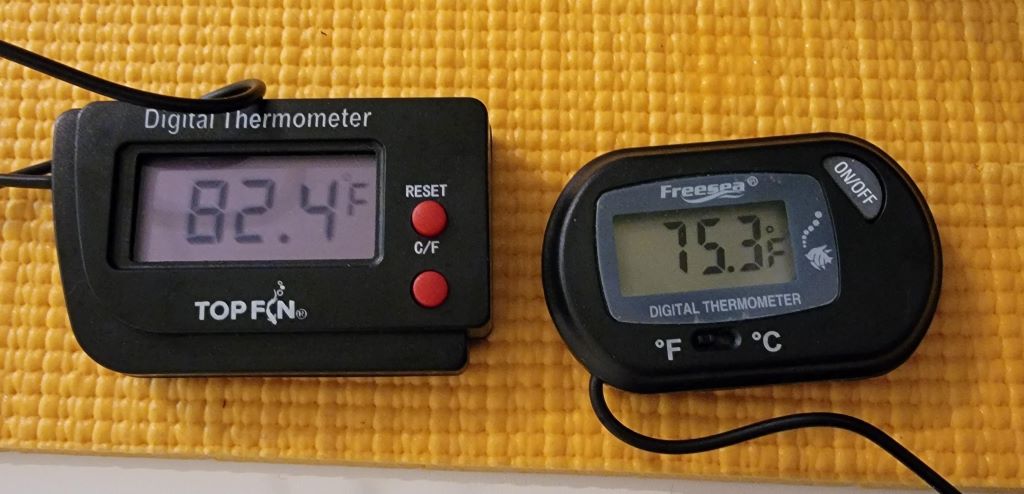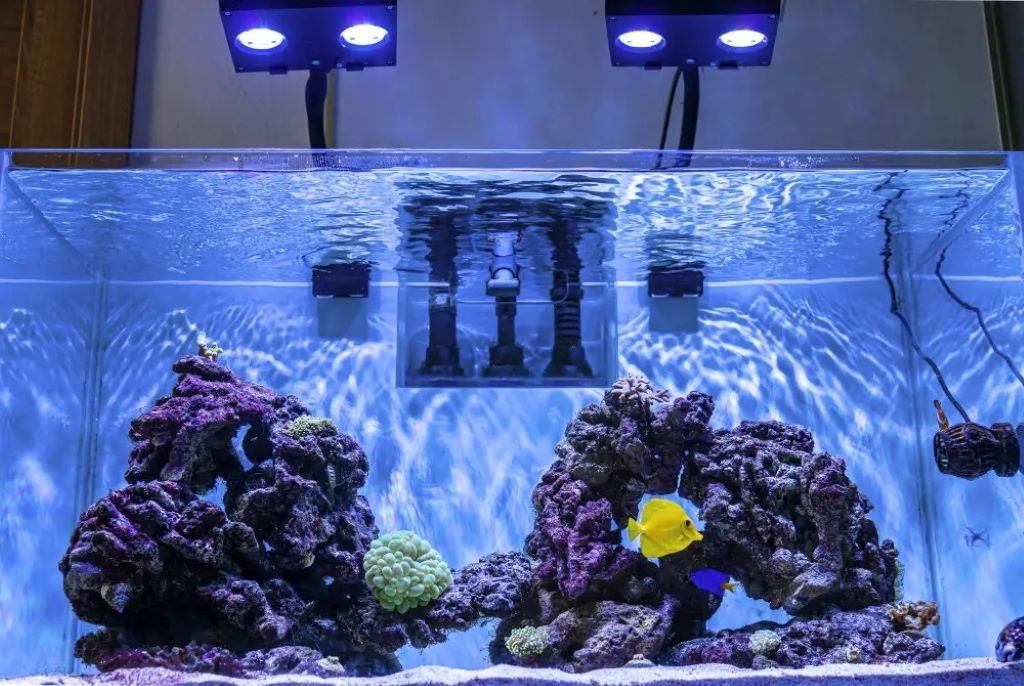
Reef tank temperature swings solution
Stability is the cornerstone of a successful reef aquarium. As a reefer, you dedicate time and effort to balancing lighting, flow, and water chemistry. However, one of all parameters, temperature, is often the silent killer. A sudden spike or dip can stress your entire system, leading to coral bleaching, disease, and loss of livestock. If you’ve ever felt the panic of watching your thermometer display a number far outside the safe zone, you are not alone. This is a common challenge, but it is solvable. Finding a solution for your reef tank temperature swings is not just about convenience; it is about creating a stable, thriving ecosystem. That’s why successful hobbyists often consult expert sources, like the Reef Aquarium Blog, to build a solid foundation of knowledge.
Before we dive into solutions, it’s crucial to understand why this matters. Corals, fish, and invertebrates thrive in the ocean, a massive body of water with incredibly stable conditions. They are not built to handle rapid change. While many hobbyists debate the single best number, the general consensus for an ideal reef tank temperature is typically between 75°F and 78°F (24°C to 26°C). The real goal, however, is not to hit a magic number, but to maintain a stable temperature within that range. A daily swing of more than 1-2°F can begin to stress corals. These fluctuations force your tank’s inhabitants to constantly adjust their metabolism, which consumes energy needed for growth and coloration.
Therefore, controlling your reef tank temperature is a primary task. This article will guide you through identifying the causes of these dangerous swings, providing practical solutions for both overheating and overcooling, and explaining the equipment that can automate this process, giving you peace of mind.
Why Temperature Stability Is Critical for Your Reef Tank
In the wild, coral reefs are massive ecosystems. The sheer volume of water acts as a powerful buffer against temperature changes. A hot day or a cool night barely registers. Your aquarium, by contrast, is a tiny, enclosed system. It is highly susceptible to both internal and external influences.
When your reef tank temperature swings too high, the consequences can be devastating. The most well-known effect is coral bleaching. High temperatures cause corals to expel the symbiotic algae (zooxanthellae) that live in their tissues. These algae provide the coral with both its color and the majority of its food. Without them, the coral turns white and begins to starve.
However, the damage is not limited to bleaching.
- Fish Stress: Rapid temperature changes weaken a fish’s immune system, making it more vulnerable to common diseases like Ich (Cryptocaryon irritans) and Marine Velvet (Amyloodinium ocellans).
- Invertebrate Health: Shrimps, snails, and crabs are also sensitive. Extreme shifts can shock their systems, leading to lethargy or death.
- Pest Algae Growth: Many nuisance algae and bacteria, such as dinoflagellates, can thrive in warmer, more unstable conditions where corals are struggling.
- Reduced Oxygen: Warmer water holds less dissolved oxygen, which can stress all aerobic life in your tank, especially heavily stocked systems.
Low-temperature swings are also problematic. If the water gets too cold, the metabolism of your fish and corals slows down dramatically. This can stop coral growth, reduce feeding responses, and make inhabitants appear sluggish and unwell.
Identifying the Causes of Temperature Swings
You cannot solve a problem until you identify its source. Temperature fluctuations are almost always caused by a combination of factors related to your equipment and your home’s environment.
External Factors: The Room Environment
Your tank lives in your home, and your home’s climate is its first challenge.
- Ambient Room Temperature: This is the most significant factor. A house that gets hot during the day while you are at work will transfer that heat directly into your tank. Likewise, a cold snap or drafty window in winter can pull heat out faster than your heater can replace it.
- Storage in a basement, for example, often leads to a constant battle with low temperatures.
- Direct Sunlight: Never place a reef tank where it can be hit by direct sunlight. Even one hour of direct sun can act like a high-powered lamp, rapidly overheating the water.
- Ventilation: A room with poor airflow can trap heat generated by your tank’s equipment, creating a feedback loop that makes the problem worse.
Internal Factors: The Equipment
The very equipment that keeps your reef alive also generates a significant amount of heat. This “heat creep” is the most common reason reef tanks overheat.
- High-Powered Lighting: This is often the number one culprit. Metal Halide (MH) lights are famous for this, but even large, powerful LED fixtures or banks of T5 bulbs produce a lot of heat. This heat radiates downward, warming the water surface.
- Pumps: Every pump in your system (return pump, wavemakers, skimmer pump) transfers heat into the water. A powerful, oversized return pump running in a tight sump compartment can act as a secondary heater.
- Heater Malfunction: Aquarium heaters are notoriously prone to failure. They can get stuck in the “on” position, cooking your tank, or fail in the “off” position, allowing it to crash during a cold night. Relying on the cheap, built-in thermostat is one of the biggest risks in the hobby.
The Overheating Problem: Solutions for Cooling Your Reef Tank
For most reefers, the primary battle is against heat. The combination of high-powered lights and pumps almost always adds more heat than is needed.
Simple and Low-Cost Cooling Methods
Before investing in expensive equipment, try these simple solutions.
- Evaporative Cooling (Fans): This is the most effective low-cost method. Aim one or more small fans to blow directly across the surface of your water, usually in the sump. As the water evaporates, it pulls heat from the aquarium, a process known as evaporative cooling. This can easily lower your tank temperature by 2-5°F. The main downside is that it significantly increases evaporation, so your auto-top-off (ATO) system will work harder.
- Manage Room Temperature: The easiest fix is to control the room itself. Use your home’s air conditioning to keep the ambient temperature stable. During hot days, close blinds or curtains to block sunlight.
- Adjust Your Lighting Schedule: If your lights are the main issue, consider reducing the photoperiod by an hour. Alternatively, you can shift your lighting schedule to run during the coolest part of the day, such as overnight, though this may make it harder for you to enjoy your tank.
- Sump and Cabinet Ventilation: Your sump cabinet can trap heat from pumps and skimmers. Ensure it has proper ventilation. You can even install a small computer fan to pull hot air out of the stand.

The Ultimate Solution: The Aquarium Chiller
If low-cost methods are not enough, you need a dedicated aquarium chiller. A chiller is essentially a refrigerator for your water. Water is pumped from your sump, through the chiller unit where heat is removed, and then returned to the sump.
Pros of a Chiller:
- Precise Control: You can set a target temperature, and the chiller will automatically turn on to maintain it.
- Powerful: A properly-sized chiller can handle extreme heat loads from powerful equipment and hot climates.
- Peace of Mind: It is the ultimate “set it and forget it” solution for overheating.
Cons of a Chiller:
- Cost: They are a significant investment, often costing several hundred to over a thousand dollars.
- Noise and Heat: A chiller removes heat from the water and exhausts it into your room. This can make the room itself warmer and louder.
- Plumbing: It requires additional plumbing and a dedicated pump or manifold to run.
When sizing a chiller, it is always better to buy one slightly oversized for your system. An undersized unit will run constantly, wearing out faster and struggling to keep up.
The Overcooling Problem: Solutions for Stable Heating
While less common, keeping a tank warm is a major challenge for those in cold climates or with tanks in basements.
The Right Heater (and a Backup)
Your heater is the single most important piece of equipment for preventing a temperature crash. Do not try to save money here.
- Wattage Rule: A general rule of thumb is 3-5 watts of heating power per gallon of water. For a 100-gallon tank, you would want 300-500 watts.
- The Two-Heater Rule: Never rely on a single heater. It is far safer to use two smaller heaters that add up to your required wattage. For example, instead of one 300-watt heater, use two 150-watt heaters. This provides redundancy. If one fails, the other can likely keep the tank from crashing until you notice. If one gets stuck “on,” it is less likely to overheat the tank as quickly as a single, oversized unit.
- Quality Matters: Invest in a high-quality heater brand with a reliable track record. Titanium-element heaters are often considered the most durable.
The Single Best Tool: The External Temperature Controller
Whether your problem is overheating or overcooling, the single best solution for stability is an external temperature controller.
This device acts as the “brain” for your heating and cooling equipment. You place its temperature probe in your tank and plug your heater and/or your fans/chiller into the controller’s outlets.
Here is why it is essential:
- Superior Accuracy: The controller’s probe and thermostat are far more accurate and reliable than the cheap bimetallic strips found in most heaters.
- Failsafe Protection: This is its most important feature. You set your heater’s built-in thermostat a few degrees higher than your controller’s setting. For example, set the controller to 77°F and the heater itself to 80°F. Now, the controller will turn the heater on and off at 77°F. If the controller fails, the heater’s own thermostat will still shut it off at 80°F, preventing a catastrophe.
- Dual Control: Most controllers have two outlets: one for heating and one for cooling. You can set it to turn on your heater if the temp drops to 76.5°F and turn on your fans or chiller if it rises to 77.5°F. This creates a fully automated, stable temperature “sweet spot.”
Monitoring: Your First Line of Defense
You cannot fix a problem you do not know you have. Reliable monitoring is non-negotiable.
- Calibrated Thermometers: Do not trust a single thermometer. Use at least two different digital or high-quality glass thermometers to verify readings.
- Controller Alarms: Many modern temperature controllers (like those from Inkbird, Neptune Systems, or GHL) have built-in alarms. They can send an alert to your phone if the temperature goes outside your set safe range. This feature alone can save your entire tank.
Conclusion: Achieving Perfect Stability
Solving reef tank temperature swings is about creating a stable system, not just reacting to emergencies. The key is a multi-layered approach.
First, identify the sources of your temperature swings by looking at your room’s environment and your equipment’s heat output. Second, implement solutions. Use fans for minor overheating and invest in a chiller for major heat problems. For cold, use two high-quality heaters.
Finally, and most importantly, automate your system with a reliable external temperature controller. This device will act as your tank’s thermostat, managing your heaters and cooling equipment to lock in your desired temperature. By taking control of this vital parameter, you eliminate one of the greatest sources of stress for both you and your tank’s inhabitants, paving the way for a healthy, growing, and vibrant reef.
Frequently Asked Questions (FAQs)
-
What is the ideal reef tank temperature?
Most experts agree that a stable temperature between 75°F and 78°F (24°C-26°C) is ideal for a mixed reef tank. The most important thing is not the exact number, but keeping it stable within that range.
-
How much can a reef tank temperature swing in a day?
You should aim for as little swing as possible. A swing of 1-2°F over a 24-hour period is acceptable. Swings larger than 2°F can begin to cause stress to sensitive corals and fish.
-
Do I really need a reef tank chiller?
It depends. If you live in a hot climate, run powerful equipment (like metal halide lights or large pumps), and cannot keep your ambient room temperature cool with AC, then a chiller is often a necessary investment to prevent chronic overheating.
-
Will a fan blowing on my sump really cool the tank?
Yes. This is called evaporative cooling, and it is very effective. As water evaporates from the surface, it takes heat with it, which can lower the tank’s temperature by several degrees. The trade-off is that you will need to refill your auto-top-off (ATO) reservoir more frequently.
-
Is it better to have two heaters in a reef tank?
Absolutely. Using two smaller heaters instead of one large one provides redundancy. If one heater fails in the “off” position, the other will help prevent a dangerous temperature drop. If one fails in the “on” position, it will take longer to dangerously overheat the tank, giving you more time to catch the problem.
Related Topics:
10 Proven Fish Breeding Techniques in Home Aquariums
Top 10 best shopping destinations in the United States


Average Rating